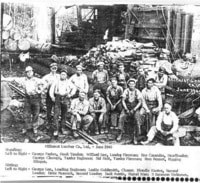The exact date of the beginning of commercial logging in the area is unknown but research shows that in 1879 a timber lease, worth an estimated 7,000 + acres of timber, was granted to two men, Sutton and W. Robertson.
Over the following decades hundreds of lumbering operations (logging operations, lumber mills and shake and shingle mills) employing thousands of workers have come and gone. Years and years of continual logging of the timber rich local mountains eventually took its toll. By the beginning of the 21st Century there were but a few “gypo” (logging) operations left. The business of harvesting the forests at non stop pace had run it’s course, ending in January 2001 with the (demise) permanent closure of the last of the area’s “three big mills” namely BCFP lumber mill at Youbou.
It had been a grand beginning for the industry as a whole and later, the three biggest mills of the Cowichan Lake area. Commencing in the early 1900’s, Cottonwood (later called Youbou) Empire Lumber Company mill and logging operation was off to a start. With the eventual construction of company residential houses as well as a school, church, stores and other community buildings, the settlement was well on it’s way to becoming a well planned close-knit community.
The first of the big three mills to close was Hillcrest Lumber Company’s (HLC) mill at Mesachie Lake along with its nearby logging operations. HLC operated continuously from 1943 until 1969, when the mill was dismantled removed. Although the community survived, the land the mill was located on was sold. Today the former old mill site belongs to Camp Imadene while the pleasant residential area continues to provide homes for families.
The second of the Big Three lumber mills to close permanently (1981) was Honeymoon Bay’s Western Forest Products lumber mill and its logging operation. In 1942, Lake Logging Company “built a 100,000 capacity plant “ (Western Forest Products website) at Honeymoon Bay. There were several small-specialized mills within the plant including the band mill and Swedish gang mill, which were used to cut smaller logs, supplied by lumberman (Kansas native) Ralph Round’s nearby timber claim. Also built was a new logging operation at Meade Creek. The camp was located on property that present day Cowichan Lake CVRD Incinerator garbage dump and several nearby forestry related businesses, occupy.
“Over the years Western Forest Industries undertook a $1 million expansion of the Honeymoon Bay community and construction of a new logging camp near Gordon River. In 1948, WFI at Honeymoon Bay invested $2 million in the sawmill, shingle mill and power plant that had been destroyed by fire. “Western Forest Industries new camp at Gordon River was recognized as the most modern camp in the country. Its cookhouse was said to be the first completely outfitted with steam tables and could serve 350 at a sitting. The camp contained 18 bunkhouses each rooming 16, plus 11 duplexes for families and 6 individual quarters for staff.”
By 1981, except for the mill itself, nearly all of WFI’s local holdings, including it’s logging community at Gordon River, were gone. The Ottawa Citizen newspaper dated Oct. 18, 1981 reported under the headline “Decision to Close [mill] is Betrayal say Sawmill workers” and that “400 primary jobs in the {Cowichan} Valley were lost”. The mill was later dismantled with the land it stood on, sold for the building of new residential homes and RV parks. The thriving community of Honeymoon Bay remains a pleasant place just as it did in former years.
After the closure of each of the three big mills, the once-company-owned communities felt the loss, financially and otherwise. Although many were forced to move to places where they could find employment, there were also those who stayed and were joined by newcomers, who together worked toward ensuring that their communities would survive.
